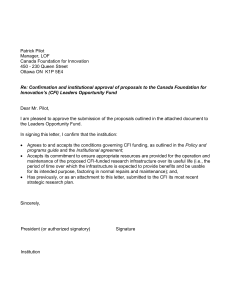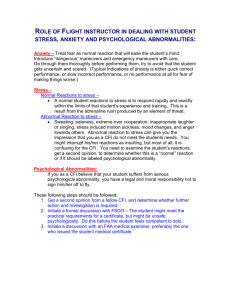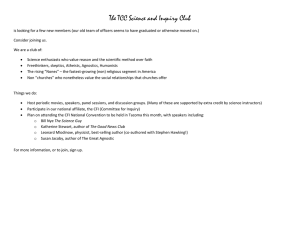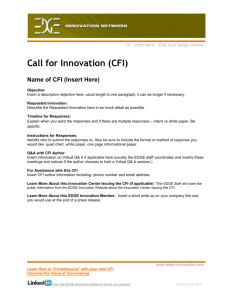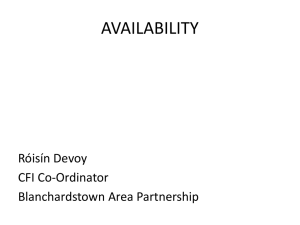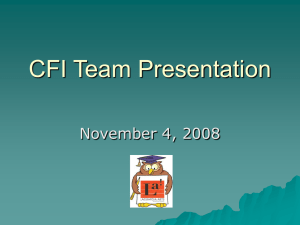Control-Flow Integrity Vitaly Shmatikov CS 6431
advertisement
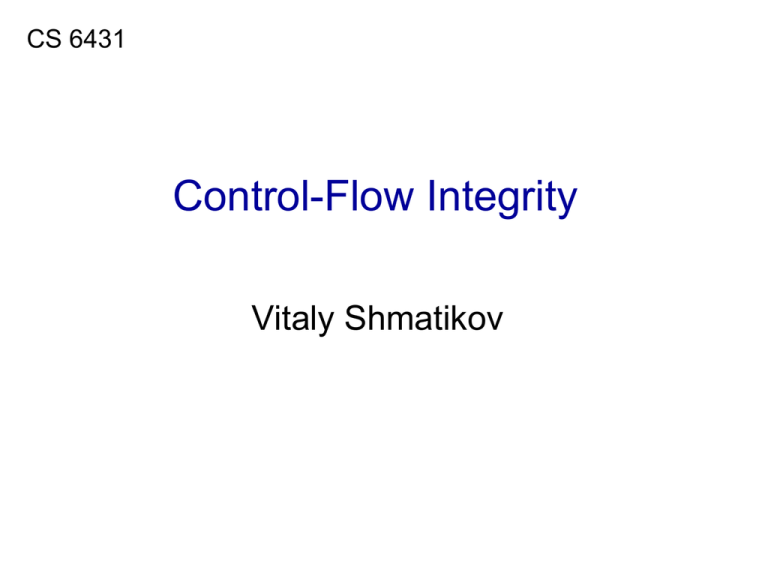
CS 6431 Control-Flow Integrity Vitaly Shmatikov Reference Monitor Observes execution of the program/process • At what level? Possibilities: hardware, OS, network Halts or confines execution if the program is about to violate the security policy • What’s a “security policy”? • Which system events are relevant to the policy? – Instructions, memory accesses, system calls, network packets… Cannot be circumvented by the monitored process slide 2 Enforceable Security Policies [Schneider 1998] Reference monitors can only enforce safety policies • Execution of a process is a sequence of states • Safety policy is a predicate on a prefix of the sequence – Policy must depend only on the past of a particular execution; once it becomes false, it’s always false Not policies that require knowledge of the future • “If this server accepts a SYN packet, it will eventually send a response” Not policies that deal with all possible executions • “This program should never reveal a secret” slide 3 Reference Monitor Implementation Kernelized Wrapper Program RM Kernel Modified program RM Program Kernel Program RM Kernel Integrate reference monitor into program code during compilation or via binary rewriting – Policies can depend on application semantics – Enforcement doesn’t require context switches in the kernel – Lower performance overhead slide 4 What Makes a Process Safe? Memory safety: all memory accesses are “correct” • Respect array bounds, don’t stomp on another process’s memory, don’t execute data as if it were code Control-flow safety: all control transfers are envisioned by the original program • No arbitrary jumps, no calls to library routines that the original program did not call Type safety: all function calls and operations have arguments of correct type slide 5 Software Fault Isolation (SFI) [Wahbe et al. SOSP 1993] Processes live in the same hardware address space; software reference monitor isolates them • Each process is assigned a logical “fault domain” • Check all memory writes and jumps to ensure they don’t leave process’s domain Tradeoff: checking vs. communication • Pay the cost of executing checks for each memory write and control transfer to save the cost of context switching when trapping into the kernel slide 6 Fault Domains Process’s code and data in one memory segment • Identified by a unique pattern of upper bits • Code is separate from data (heap, stack, etc.) • Think of a fault domain as a “sandbox” Binary modified so that it cannot escape domain • Addresses are masked so that all memory writes are to addresses within the segment – Coarse-grained memory safety (vs. array bounds checking) • Code is inserted before each jump to ensure that the destination is within the segment Does this help much against buffer overflows? slide 7 Verifying Jumps and Stores If target address can be determined statically, mask it with the segment’s upper bits • Crash, but won’t stomp on another process’s memory If address unknown until runtime, insert checking code before the instruction Ensure that code can’t jump around the checks • Target address held in a dedicated register • Its value is changed only by inserted code, atomically, and only with a value from the data segment slide 8 Simple SFI Example Fault domain = from 0x1200 to 0x12FF Original code: write x Naïve SFI: x := x & 00FF convert x into an address that lies within the fault domain x := x | 1200 … What if the code jumps right here? write x Better SFI: tmp := x & 00FF tmp := tmp | 1200 write tmp slide 9 Inline Reference Monitor Generalize SFI to more general safety policies than just memory safety • Policy specified in some formal language • Policy deals with application-level concepts: access to system resources, network events, etc. – “No process should send to the network after reading a file”, “No process should open more than 3 windows”, … Policy checks are integrated into the binary code • Via binary rewriting or when compiling Inserted checks should be uncircumventable • Rely on SFI for basic memory safety slide 10 CFI: Control-Flow Integrity [Abadi et al. “Control-Flow Integrity”. CCS 2005] Main idea: pre-determine control flow graph (CFG) of an application • • • • Static analysis of source code Static binary analysis CFI Execution profiling Explicit specification of security policy Execution must follow the pre-determined control flow graph slide 11 CFI: Binary Instrumentation Use binary rewriting to instrument code with runtime checks (similar to SFI) Inserted checks ensure that the execution always stays within the statically determined CFG • Whenever an instruction transfers control, destination must be valid according to the CFG Goal: prevent injection of arbitrary code and invalid control transfers (e.g., return-to-libc) • Secure even if the attacker has complete control over the thread’s address space slide 12 CFG Example slide 13 CFI: Control Flow Enforcement For each control transfer, determine statically its possible destination(s) Insert a unique bit pattern at every destination • Two destinations are equivalent if CFG contains edges to each from the same source – This is imprecise (why?) • Use same bit pattern for equivalent destinations Insert binary code that at runtime will check whether the bit pattern of the target instruction matches the pattern of possible destinations slide 14 CFI: Example of Instrumentation Original code Instrumented code Jump to the destination only if the tag is equal to “12345678” Abuse an x86 assembly instruction to insert “12345678” tag into the binary slide 15 CFI: Preventing Circumvention Unique IDs • Bit patterns chosen as destination IDs must not appear anywhere else in the code memory except ID checks Non-writable code • Program should not modify code memory at runtime – What about run-time code generation and self-modification? Non-executable data • Program should not execute data as if it were code Enforcement: hardware support + prohibit system calls that change protection state + verification at load-time slide 16 Improving CFI Precision Suppose a call from A goes to C, and a call from B goes to either C, or D (when can this happen?) • CFI will use the same tag for C and D, but this allows an “invalid” call from A to D • Possible solution: duplicate code or inline • Possible solution: multiple tags Function F is called first from A, then from B; what’s a valid destination for its return? • CFI will use the same tag for both call sites, but this allows F to return to B after being called from A • Solution: shadow call stack slide 17 Possible Execution of Memory [Erlingsson] slide 18 CFI: Security Guarantees Effective against attacks based on illegitimate control-flow transfer • Stack-based buffer overflow, return-to-libc exploits, pointer subterfuge Does not protect against attacks that do not violate the program’s original CFG • Incorrect arguments to system calls • Substitution of file names • Other data-only attacks slide 19 “Data-Only” Attacks Why is this important? How can an attacker use a “data-only” attack to execute his code? Program already has control flow that depends on data read from memory • Indirect function call where the destination and the arguments depend on data read from memory Does fine-grained CFI help? • Depends on the precision of pointer analysis (why?) slide 20 Example: Apache HTTPD [Evans et al. “Control Jujutsu”. CCS 2015] “Data-only” attack writes a pointer to target function into this data structure Target = any function that executes a program whose name it reads from memory slide 21 Does Fine-Grained CFI Help? Depends on the precision of the statically computed control-flow graph • Static pointer analysis must determine that a particular function is not a valid destination of particular pointer Need field sensitivity and context sensitivity • Global struct in Apache HTTPD has multiple fields, each holds an array of pointers, which are manipulated by custom functions Existing algorithms lose precision due to pointer casts and integer-pointer conversions slide 22 Ending the Arms Race Even finer-grained CFI • The general problem is undecidable Better runtime tracking of memory bounds • Performance is a challenge • Much progress in recent years – Nagarakatte et al. “SoftBound” (PLDI 2009) – Akritidis et al. “Baggy Bounds” (USENIX Security 2009) Stop writing code in C and C++ slide 23
